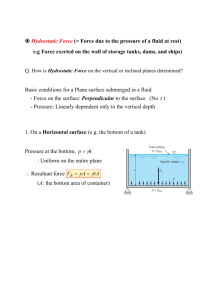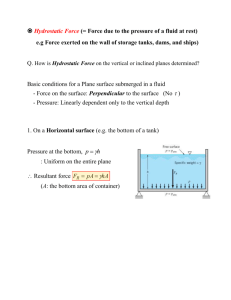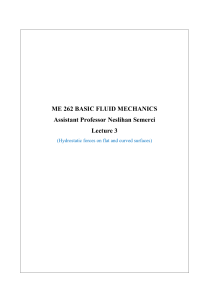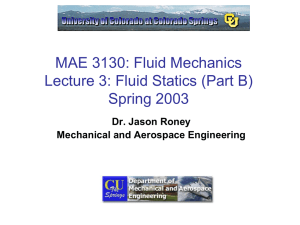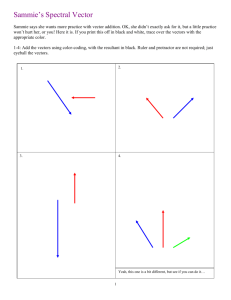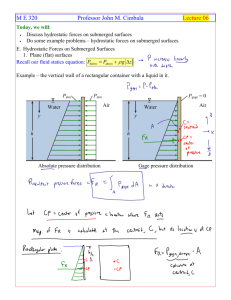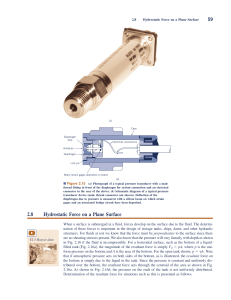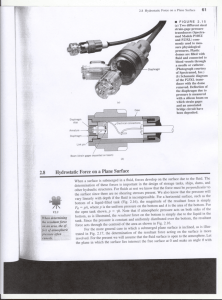Hydrostatic Force on a Plane Surface
advertisement
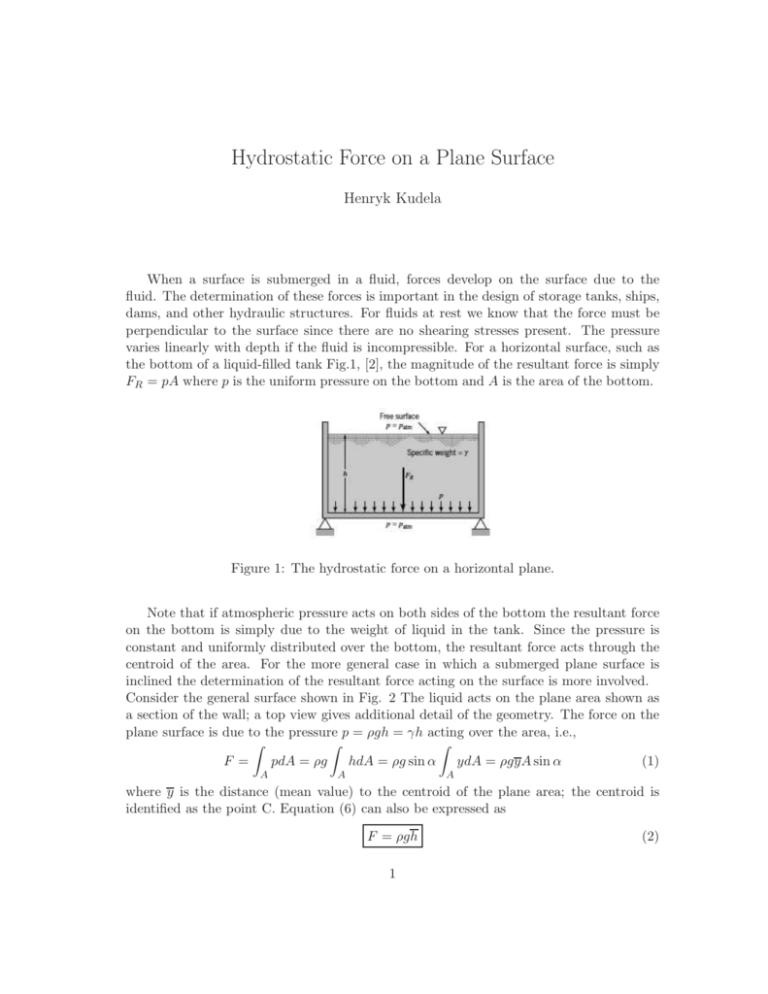
Hydrostatic Force on a Plane Surface Henryk Kudela When a surface is submerged in a fluid, forces develop on the surface due to the fluid. The determination of these forces is important in the design of storage tanks, ships, dams, and other hydraulic structures. For fluids at rest we know that the force must be perpendicular to the surface since there are no shearing stresses present. The pressure varies linearly with depth if the fluid is incompressible. For a horizontal surface, such as the bottom of a liquid-filled tank Fig.1, [2], the magnitude of the resultant force is simply FR = pA where p is the uniform pressure on the bottom and A is the area of the bottom. Figure 1: The hydrostatic force on a horizontal plane. Note that if atmospheric pressure acts on both sides of the bottom the resultant force on the bottom is simply due to the weight of liquid in the tank. Since the pressure is constant and uniformly distributed over the bottom, the resultant force acts through the centroid of the area. For the more general case in which a submerged plane surface is inclined the determination of the resultant force acting on the surface is more involved. Consider the general surface shown in Fig. 2 The liquid acts on the plane area shown as a section of the wall; a top view gives additional detail of the geometry. The force on the plane surface is due to the pressure p = ρgh = γh acting over the area, i.e., Z Z Z pdA = ρg hdA = ρg sin α ydA = ρgyA sin α (1) F = A A A where y is the distance (mean value) to the centroid of the plane area; the centroid is identified as the point C. Equation (6) can also be expressed as F = ρgh 1 (2) Figure 2: The hydrostatic force on an inclined plane area. whereh is the vertical distance to the centroid. Since ρgh is the pressure at the centroid, we see that the magnitude of the force is the area multiplied by the pressure that acts at the centroid of the area. It does not depend on the angle a of inclination. But, the force does not, in general, act at the centroid (only in the case of some symmetry of the plane). Let us assume that the force acts at some point called the center of pressure, located by the point (xp , yp ). To determine where the force acts, we must recognize that the sum of the moments of all the infinitesimal forces must equal the moment of the resultant force, i.e., Z Z yp F = ρg yhdA = ρg sin α y 2 dA = ρgIx sin α (3) A A where Ix is the second moment of the area about the x-axis. The parallel-axis transfer theorem states that Ix = Is + Ay 2 (4) where Is is the moment of the area about its centroidal axis. So, substitution of Eq. (4) into Eq. (3) and using the expression for F from Eq. (6) results in yp = y + Is Ay (5) Equation (5) permits us to calculate the location where the force acts it is the center of pressure. 2 Example 1 A 60-cm square gate (a = 0.6) has its top edge 12 m below the water surface. It is on a 45o angle and its bottom edge is hinged as shown in Fig.. What force P is needed to just open the gate? Solution: The first step is to sketch a free-body diagram of the Figure 3: The hydrostatic force on a gate. gate so the forces and distances are clearly identified. It is done in Fig.4(b). The force F is calculated to be F = ρhA = 1000 ∗ 9.81 ∗ (12 + 0.3 sin 45o )0.6 ∗ 0.6 = 43130 N (6) Now we find the distance d where the force F acts from the hinge: h 12 + 0.3 sin 45o = = 17.27 m sin 45o sin 45o Is 0.6 ∗ 0.63 yp = y + = 17.27 + = 17.272 m Ay 12 ∗ (0.6 ∗ 0.6) ∗ 17.27 d = 0.3 − (yp − y) ∼ = 0.3 m y= (7) The force P can be calculated P = d ∗ F/a = 0.1 0.343130 = 21040 N. 0.6 (8) The pressure Prism Another approach to the problem of determining the resultant force and line of action of the force on the a plane surface is given by the concept of the pressure prism. It is a prismatic volume with its base the given surface area and with altitude at any point of the base given by p = ρgh, h is the vertical distance to the free surface. 3 This ”volume” is called the pressure prism. The magnitude of the resultant force acting on the surface is equal to the volume of the pressure prism. The fluid force is 1 h F = ”volume” = (ρgh)bh = ρgh A (9) 2 2 where A = b ∗ h Figure 4: Pressure prism for vertical rectangular area. The volume of the pressure prism is equal to the fluid force. For this lecture I used the following books: References [1] F. M. White, 1999. Fluid Mechanics, McGraw-Hill. [2] B. R. Munson, D.F Young and T. H. Okiisshi, 1998. Fundamentals of Fluid Mechanics, John Wiley and Sons, Inc. . 4
